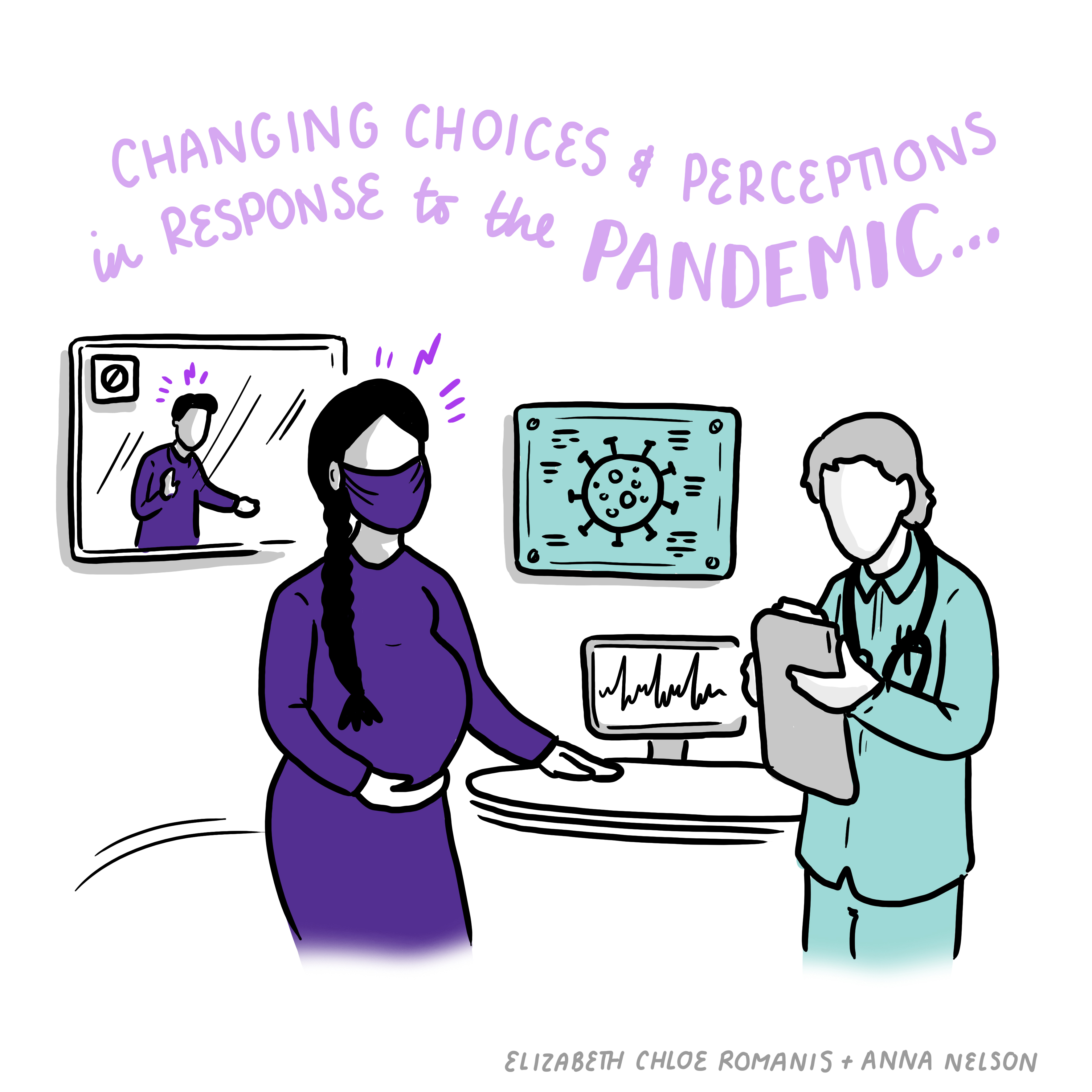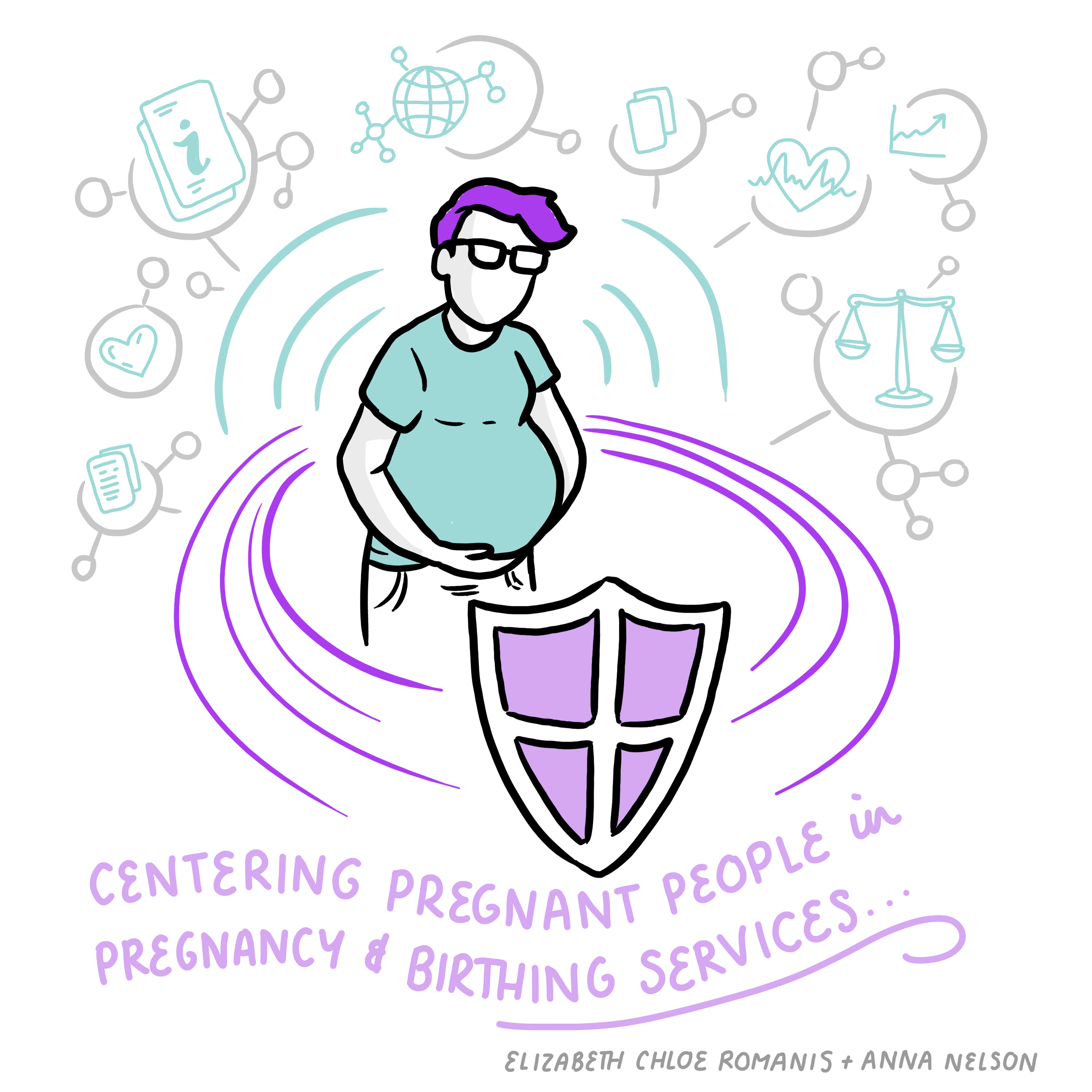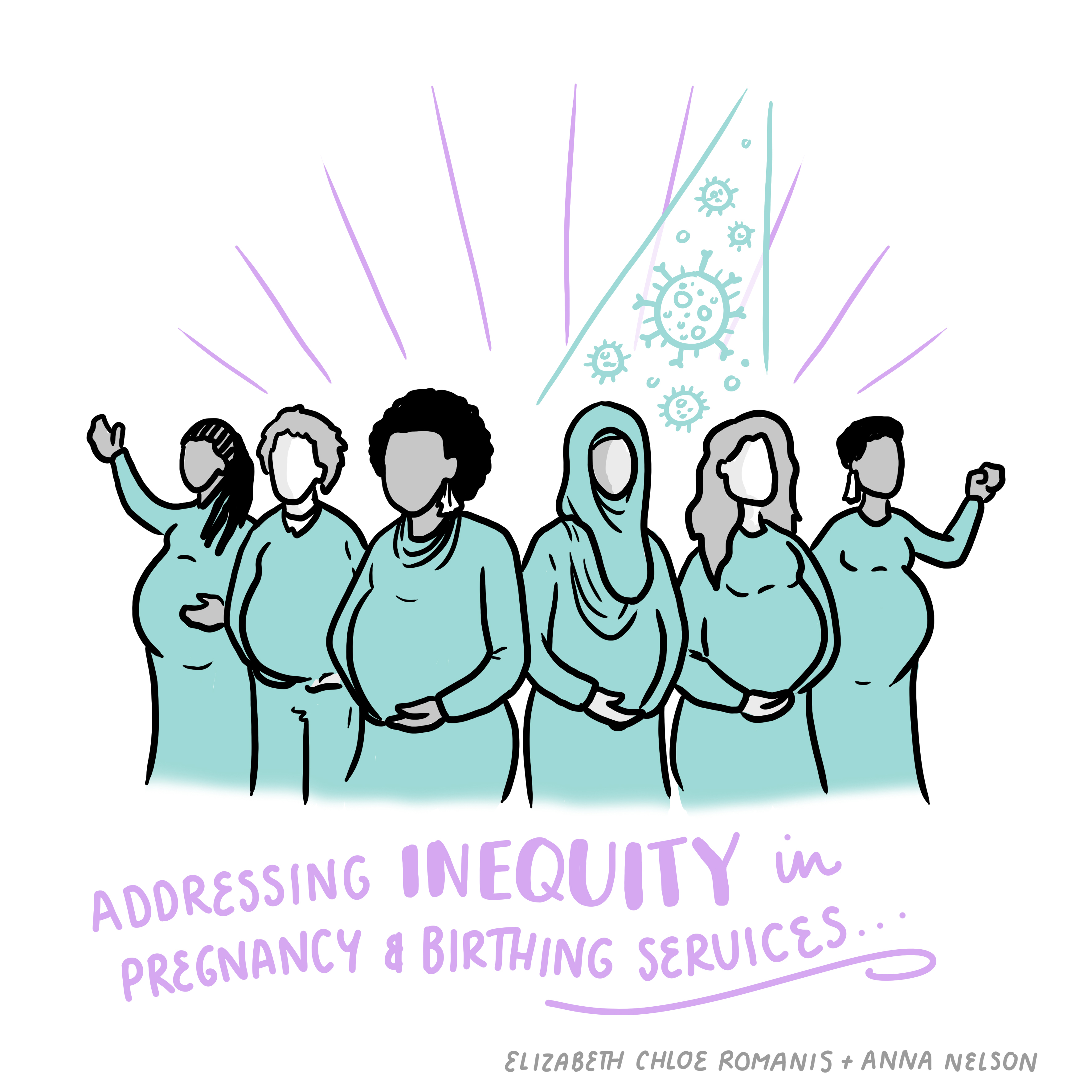By Elizabeth Chloe Romanis (@ECRomanis) & Anna Nelson (@Anna_Nelson95)
In the previous post in this series we provided an overview of the socio-legal gap that exists between the legal principle that pregnant people have a right to make choices about childbirth and the reality of the contemporary socio-legal context, which means it is difficult for this right to be realised. This was the case before the pandemic, was exacerbated during it, and without forward-thinking about how to improve access to choice this is likely to continue. In this blog, we explore the three key themes that emerged during discussions at our second SLSA-funded birth rights during COVID-19 workshop. Our exploration here is not complete, nor full, but we hope that by highlighting these themes it encourages more reflection on the issues prevalent in birthing and maternity services.
- Changing choices and changing perceptions of risk in response to the pandemic
There are some common concerns evident in the lived experiences of many people preparing to birth during COVID-19 including fears about the risk of infection in the hospital environment, not being able to have a partner present at a hospital delivery or having to spend extra time in hospital were an emergency caesarean to become necessary – amongst other things – that influenced many people’s decision-making.

Conversations about risk arise repeatedly when talking about birth choices. There remains a need for the collection of data that tells us more about the comparative risks of birthing options, and in a way that is more meaningful to pregnant people. Risk is a highly individualized concept, and perceptions about risk are influenced by, the values, desires and life of each individual. The law recognises this in emphasising the importance of informed consent.[1] When we discuss potential shifts in risk perception it is important to note that risks are universally understood in the same way by everyone[2] – and generalising should not be used to diminish the available choices.
One of the key themes emerging from the data that Mari Greenfield shared with us at the workshop was a change in how hospitals are perceived, with medical buildings and staff being seen as an innate source of risk because of the virus. This was also something that some healthcare staff may have also felt.
This shift is in direct conflict to the prevailing narrative pre-pandemic (that of medicalisation) which promoted the hospital as the safest place for birthing people. This is despite data suggesting that in non-complex pregnancies homebirth is just as safe as hospital birth – and there is a lower risk of obstetric intervention and associated complications.[3] Before the pandemic homebirth was not a particularly popular option in the UK (around 2% of people opt for homebirth)[4]. This could partly because of the pervasiveness of medicalisation. With homebirth potentially having increased during the pandemic – might there be a longer-term challenge to medicalisation enabling homebirth to be viewed as a legitimate choice? The pandemic has brought the option to the forefront, and more people are being vocal about it as an option. There may also be more lived (and shared) experience of homebirth. The pandemic has also emphasised the importance of health promotion – what impact might this have in forcing the recognition of the safety of homebirth?
- Centring pregnant people in pregnancy and birthing services
The pandemic has exemplified the fact that choice is not adequately embedded in pregnancy and birthing services. Pregnant people are not appropriately centred in their own care. Centring pregnant people means undertaking a genuine commitment to provide the information and time needed to make genuine choices about birth, and respecting these choices. In order to realise this goal, the hegemonic nature and weaponisation of ‘medicalisation’ needs to be challenged. In particular, the notion that anyone who differs from what is seen as medically optimal during birth is ‘deviant’ or ‘non-compliant’ needs to be displaced. This is not an easy task, as these notions about the behaviour of birthing people tie into wider (often gendered) perceptions about what it is to be a ‘good mother.’

Though in law, a birthing person with capacity is entitled to refuse any medical intervention (including going in to hospital) there are a myriad of ways in which the effectiveness of this is undermined in reality.[5] The law in this area needs to be effectively implemented. This is only possible if such efforts coincide with a concerted effort to dismantle the patriarchal and hierarchal systems that underpin the law[6] – these again relate to the notions of a ‘responsible pregnant person’ behaving like a ‘good mother’ and complying with medical advice. One way in which the implementation of the must be changed is by engraining a more holistic understanding of ‘health’ and ‘safety’ with regard to birthing. This understanding needs to recognise that the physical and mental health of the birthing person are a primary consideration, rather than simply the delivery of a physically healthy baby.
It is important that people know what their rights are under the law (through antenatal education) but also that medical staff know what the law requires them to facilitate in practical terms to enable a shared understanding of the person’s values to enable proper decision-making. A further problem is that sometimes staff are made to feel responsible for pregnant people’s decision making, and fear reprisal and blame if something goes wrong, even if this was a risk the pregnant person knowing accepted. This is a systemic barrier to the centring of pregnant people; only when staff know they will be supported in their decisions to respect autonomous choices of birthing people no matter the consequences will they feel empowered to truly and fully do so in instances where refusals seem likely to lead to medically ‘negative’ outcomes. This will facilitate and preserve trust between birthing people and healthcare professionals.
- Addressing inequity in pregnancy and birthing services
COVID-19 magnified what we already knew; there is inequity in access to pregnancy and birthing services. Some trusts managed to maintain access to homebirthing services throughout the pandemic, while others suspended these for months, there were different rules about how many birth partners could be present across Trusts and it took some places far longer than others to begin to allow partners to attend scans again.

Differences in knowledge about the way the NHS works and what individuals are entitled to, leads to further inequity in access to services. People do not always have to seek pregnancy and birthing care at their nearest hospital, and many share their experience of travelling much further from home to engage with a Trust they know will accommodate their preferences. However, not everyone is aware this is possible –as an option this is only available to people with considerable education, or other privilege. Individuals from lower socioeconomic groups are “prone to have lower awareness of… their rights and choices about the maternity care to which they were entitled.” Indeed, not everyone has the time or resources to travel to access care.
The issue runs much deeper than divisions between different services. There are also differences in the way that services are experienced by different people. One cannot meaningfully address the issues present within pregnancy and birthing services without acknowledging that, as with the rest of the healthcare system, these services are structurally racist. This is most starkly illustrated by the findings in the 2019 MBRACE Report that black women were 5x more likely to die during pregnancy, childbirth and the immediate post-partum period, and Asian women twice as likely. Many black women report feeling like white pregnant people ‘seemed to be listened to in more depth and with a sense of empathy’ that they do not experience. This reinforces the importance of healthcare professionals listening to pregnant people – and doing so equally. There is a need for systematic change in pregnancy and birthing services to ensure that structural changes are made. This starts by acknowledging there is a problem, and forcing conversations about why we treat pregnant – and specifically black and brown pregnant – people differently.
Concluding Reflections
The two workshops examining birthing during COVID-19 illustrated how the pandemic has shone a spotlight on the extent to which pregnant people do not have their bodies, their privacy and their values respected during birthing. This is evident in the potential increase in unconsented or inadequately consented vaginal examinations, and in the restrictions on birthing options that may have become even more important to some individuals. With more attention now on these long-existing systemic problems we hope that there might come movement towards change.
***
All of the images at our events were produced by scribe Amber Anderson.
[1] Montgomery v Lanarkshire Health Board [2015] UKSC 11.
[2] Elizabeth Chloe Romanis, ‘Addressing Rising Caesarean Rates: Maternal Request Caesareans, Defensive Practice, and the Power of Choice in Childbirth’ (2020) 13 IJFAB 1.
[3] Birthplace in England Collaborative Group ‘Perinatal and maternal outcomes by planned place of birth for healthy women with low risk pregnancies: the Birthplace in England national prospective cohort study’ (BMJ Research, 25 November 2011) <https://www.bmj.com/content/343/bmj.d7400> accessed 22 April 2021).
[4] Office for National Statistics, ‘Birth characteristics in England and Wales: 2017’ (ONS, 10 January 2019) <https://www.ons.gov.uk/peoplepopulationandcommunity/birthsdeathsandmarriages/livebirths/bulletins/birthcharacteristicsinenglandandwales/2017> (accessed 22 April 2021).
[5] Samantha Halliday, ‘Court-authorised Obstetric Intervention Insight and Capacity, a Tale of Loss’ in Camilla Pickles and Jonathon Herring (eds), Childbirth, Vulnerability and Law Exploring Issues of Violence and Control (Routledge, 2019); Sara Fovargue and José Miola ‘Are we Still Policing Pregnancy’ in Catherine Stanton, Sarah Devaney, Anne-Maree Farrell and Alex Mullock (eds) Pioneering Healthcare Law: Essays in Honour of Margaret Brazier (Routledge 2016).
[6] Camilla Pickles and Jonathon Herring (eds), Childbirth, Vulnerability and Law Exploring Issues of Violence and Control (Routledge, 2019).

Leave A Comment